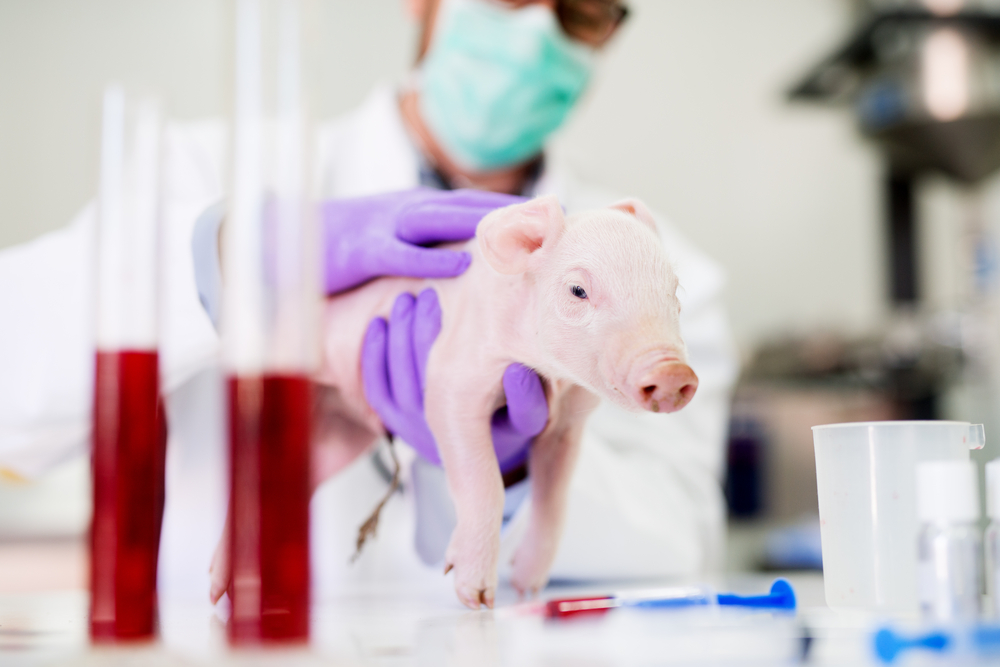Did you know that the Ford Motor Company funded a study in 2018 that used 27 innocent pigs that were killed and then tested on to help researchers learn about the impact of car crashes on children?
It’s true … The study is titled “Side Impact Assessment and Comparison of Appropriate Size and Age Equivalent Porcine Surrogates to Scaled Human Side Impact Response Biofidelity Corridors.” It was conducted at Wayne State University and it happened decades after all crash tests on animals were banned.
Take a look at the horrific pictures below:
More Details of the Experiment
The study was conducted by four researchers which included a former Ford employee. They started by determining appropriate-sized pig surrogates for humans that were 3-years old, 6-years old, 10-year olds, and 50th percentile males. The animals were acquired from Michigan State University and then they were euthanized prior to the actual test.
The pigs’ bodies were hung by wires through their spines and slammed by a high-impact pendulum. The researchers wanted to determine whether side impacts had any equivalent effects that could translate to the reactions of human bodies in motor vehicle crashes.
The findings were published in the Stapp Car Crash Journal in November of 2018.
Animals Being Used for Studies Around the World
Unfortunately, this isn’t an isolated incident. Pigs were also used as crash test dummies in China.
A case study revealed that researchers have been involved with inhumane animal testing. In one study, 15 young pigs were involved. The pigs were starved for 24 hours and denied water for six hours before the tests began. They were then strapped into car seats and used for high-speed crash impact testing.
Seven of the young live pigs were killed after being strapped onto sleds before slamming them into a wall at 30 mph. The remaining eight suffered injuries that included bleeding, broken bones, and internal bruising. They were also, understandably, heavily traumatized.
After the tests, the bodies were examined and the researchers found that lungs were the organs injured most frequently, followed by spleens, and then livers.
Out of the 15 pigs that were used, most were young, some only 70 to 80 days old to mimic the size of a young human child.
The scientists involved claimed that they were compliant with guidelines and that the studies were approved by an ethics committee. The scientists also hinted that they may do similar tests in the future.
Still More Tests
Animal involved research was reported in the International Journal of Crashworthiness which tested three different seat belt modifications: two parallel belts restraining chest and abdomen, one diagonal belt and a lap belt, and crossed diagonal belts.
In these tests, the animals were given an anesthetic to reduce “excitement and stress” and electrodes were inserted into their abdomens.
The tests resulted in seven animal deaths and common injuries of abrasion, contusion, laceration, bleeding, and fractures.
How Effective Are These Tests?
Despite the existence of sophisticated animal-free testing models and alternatives, scientists continue to use innocent animals in their research.
How effective is it really to fasten frightened animals into car seats and crash them into walls until they are dead or badly crippled? These pigs are beaten down, leaving them with broken bones and severe internal injuries. Then they are killed and dissected.
Animal bodies are different from human ones and pigs don’t naturally fit into car seats. Their anatomy is so different that the data obtained from these horrific experiments can’t truly be applicable to human car-crash victims.
Even some experts who believe in using animals in research are against such research!

At Karmagawa and SaveTheReef we’re upset that innocent animals are suffering because of experiments that provide data that has questionable relevance. There is technology available that is a good alternative to animal-involved research. Today, companies are using clinical human studies, advanced computer modeling, 3D medical imaging, and sophisticated mannequins for their crash research. There are also human cadavers and virtual reality options available.
It will take education and getting the message out to make true change and that is why we are using our media channels to speak out for these voiceless creatures.
Do you want to know what is going on around the world in regards to the environment and its beautiful animals? Please follow us on Twitter and Instagram and we’ll keep sending you more updates about animals and the environment from around the world. Share our information with your friends and family so that they stay aware, as well.
Do you have stories that you want to expose through video? If so, movies are a powerful way to get your message out.
Our friend and pro filmmaker Amir Zakeri created an online class for us to help the community learn how to create their own movies and documentaries — here’s 50% off.
You’ll be helping important causes, so don’t hesitate. Get started now.
What do you think about the use of animals in crash test experiments? Should companies like Ford be held accountable? Leave a comment below.
Cover Image: C4289N/Shutterstock

